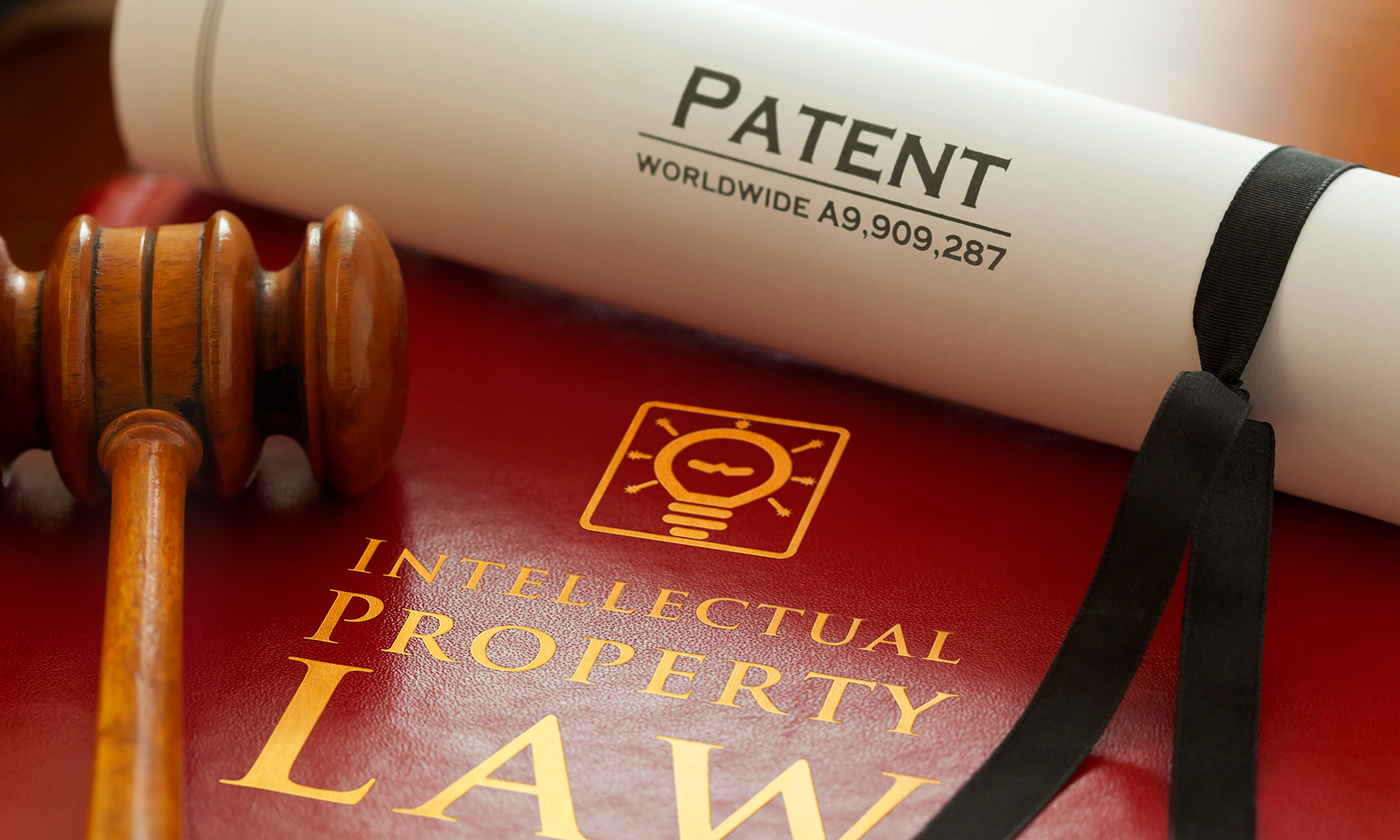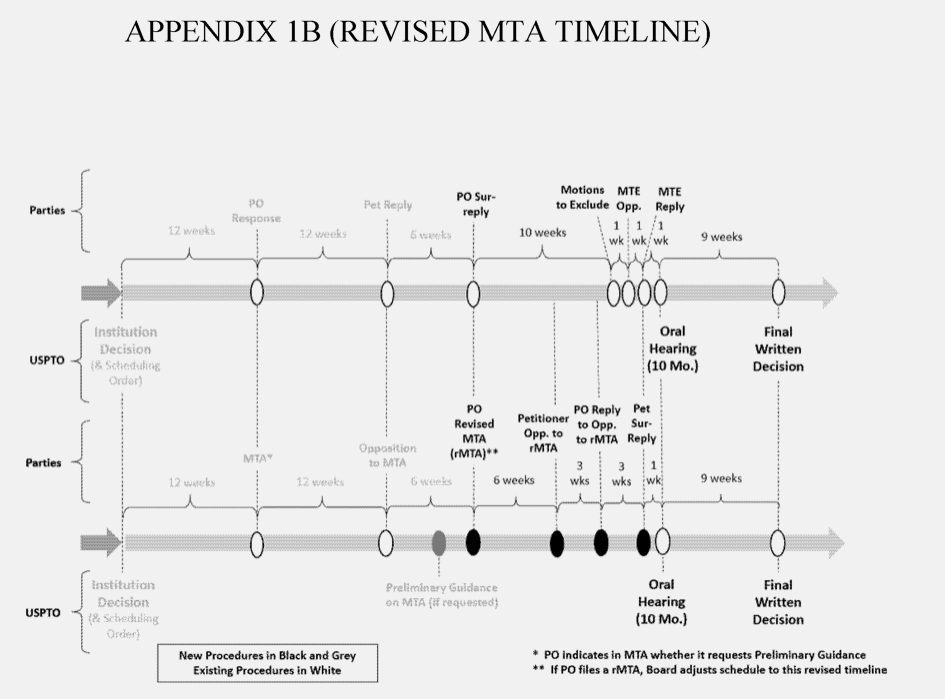Overview
As recently noticed in the Federal Register, the Patent Trial and Appeal Board’s (PTAB or Board) new motion to amend (MTA) procedures are now in effect as a one-year pilot program. [1] In sum, the patent owner (PO) now has the option to ask for preliminary guidance from the Board about its substitute claims in a first MTA, and can file a revised motion—with new substitute claims—after either the petitioner’s opposition paper or, if guidance was requested, after the Board issues its preliminary guidance. The revised MTA then generates a further opposition opportunity for the petitioner on a tight, six-week turnaround. In this article, we highlight important details of the new procedures, discuss the impact to PTAB practice, and provide some practice pointers to consider when forming PTAB strategy under the new procedures.
The notice in the Federal Register provides further detail, but the following passages and figure from the notice are particularly helpful in understanding the contours of the new program:
[A] revised MTA includes one or more new proposed substitute claims in place of previously presented substitute claims. A revised MTA also may include substitute claims, arguments, or evidence previously presented in the original MTA, but may not incorporate any material by reference from the original MTA. A revised MTA may provide new arguments and/or evidence as to why the revised MTA meets statutory and regulatory requirements for an MTA, as well as arguments and evidence relevant to the patentability of pending substitute claims. A revised MTA must provide amendments, arguments, and/or evidence in a manner that is responsive to issues raised in the preliminary guidance and/or petitioner’s opposition to the MTA. A revised MTA may not include amendments, arguments, and/or evidence that are unrelated to issues raised in the preliminary guidance and/or petitioner’s opposition to the MTA.
84 Fed. Reg. at 9,498.
[N]ewly added proposed substitute claims in the revised MTA must replace claims in the initial MTA. In addition, a patent owner may not make the claims proposed in the revised MTA contingent on the unpatentability of the claims proposed in the original MTA. If a revised MTA is filed and substitute claims need to be addressed in the final written decision, then the final written decision will address only the substitute claims at issue in the revised MTA.
Id. at 9,501.
The typical schedule will be as follows, with the black and grey ovals indicating the main events under the new procedures:
Id. at 9,507.
[P]etitioner may file an opposition to the revised MTA and preliminary guidance (if requested). Patent owner may file a reply to the opposition to the revised MTA, and petitioner may file a corresponding sur-reply. Soon after patent owner files a revised MTA, the Board will issue a new scheduling order to accommodate the necessary additional briefing. See Appendix 1B (Revised MTA Timeline). Generally, the petitioner sur-reply relating to the revised MTA will be due 1 week before the oral hearing, and the oral hearing will take place about 9 weeks before the 12-month statutory deadline for a final written decision. Id.
Id. at 9,498.
Impact
So, which PTAB proceedings are impacted and how?
- The new procedures are effective for all PTAB reviews instituted on or after March 15, 2019, i.e., essentially all petitions filed over the last six months are subject to the new procedures.
- The new procedures are generally intended to benefit POs and may increase both the number of MTA filings and, potentially, the number of successful amendments.
- The new procedures allow new claims to be proposed just 13 weeks before the proceeding’s final oral argument, with briefing running right up to one week before the argument. As such, invoking the new procedures will intensify the issues and effort in the last stages of a PTAB trial. Indeed, in certain circumstances, the claims, disputes and outcome of the entire PTAB proceeding may well be determined in the three months before oral argument.
- If a PO makes full use of the new procedures, costs will increase. In a worst case scenario for a petitioner, the petitioner has to oppose (and potentially find new prior art) in two rounds of substitute claims, while digesting and reacting to the Board’s preliminary guidance. For petitions already on file, the cost increases may exceed budgets previously quoted.
- Owners of valuable patents may be encouraged by the availability of the revised procedures, particularly in circumstances fertile for amendment, such as patents having detailed disclosure of preferred embodiments that closely resemble commercialized products.
- It is yet to be seen whether MTA filings will dramatically increase, as many patents will not provide the circumstances for a commercially viable and non-obvious amendment that meets the PO’s broader objectives.
- It is also an open question whether PTAB panels will start confirming the patentability of substitute claims at a higher rate. If not, the popularity of MTA practice may not change dramatically.
Practice Considerations
Parties should form PTAB strategies with their counsel as appropriate for their unique circumstances. In doing so, they may wish to consider the following points:
- Evaluating patent term. A substitute claim will not have the same past damages as the claim that issued with the patent. Therefore, a younger patent provides a more favorable environment for a PO to amend its claims.
- Evaluating the preferred embodiments. If the preferred embodiments disclosed in the patent at issue closely resemble industry practices and commercialized products, that closeness may provide a more favorable environment for a PO to amend its claims while achieving it broader goals of enforcement.
- Invalidating the preferred embodiments. From a petitioner’s perspective, when drafting the original petition to initiate a PTAB proceeding, it may be beneficial to invalidate the issued claims using art as close as possible to the preferred embodiments of the patent at issue, even if the breadth of the claims does not require using such art. Doing so may cut off a PO’s ability to distinguish the art using an amendment (or by arguing for a narrowing claim construction) during the PTAB proceeding.
- Using a state of the art section. Likewise, petitioners may find it helpful to develop a fairly robust “state of the art” section in the original petition with an eye to subject matter in the patent that may otherwise be attractive fodder for an amendment. Doing so may make it less likely that a PO will file a meritorious MTA. In the event that a MTA is filed, a robust state of the art section may be important to effectively opposing the MTA in an abbreviated time frame.
- Providing feedback on the “pilot” program. The Board plans to reassess the MTA pilot program after approximately one year, and reserves the right to terminate or continue the program (with or without modification) as appropriate depending on the feedback it receives. Id. at 9,497. Towards that end, the notice in the Federal Register encourages impacted members of the community to submit feedback and provides contact details for doing so. Id.
[1] Notice Regarding a New Pilot Program Concerning Motion To Amend Practice and Procedures in Trial Proceedings Under the America Invents Act Before the Patent Trial and Appeal Board, 84 Fed. Reg. 9497 (March 15, 2019) (available at https://www.govinfo.gov/content/pkg/FR-2019-03-15/pdf/2019-04897.pdf).

